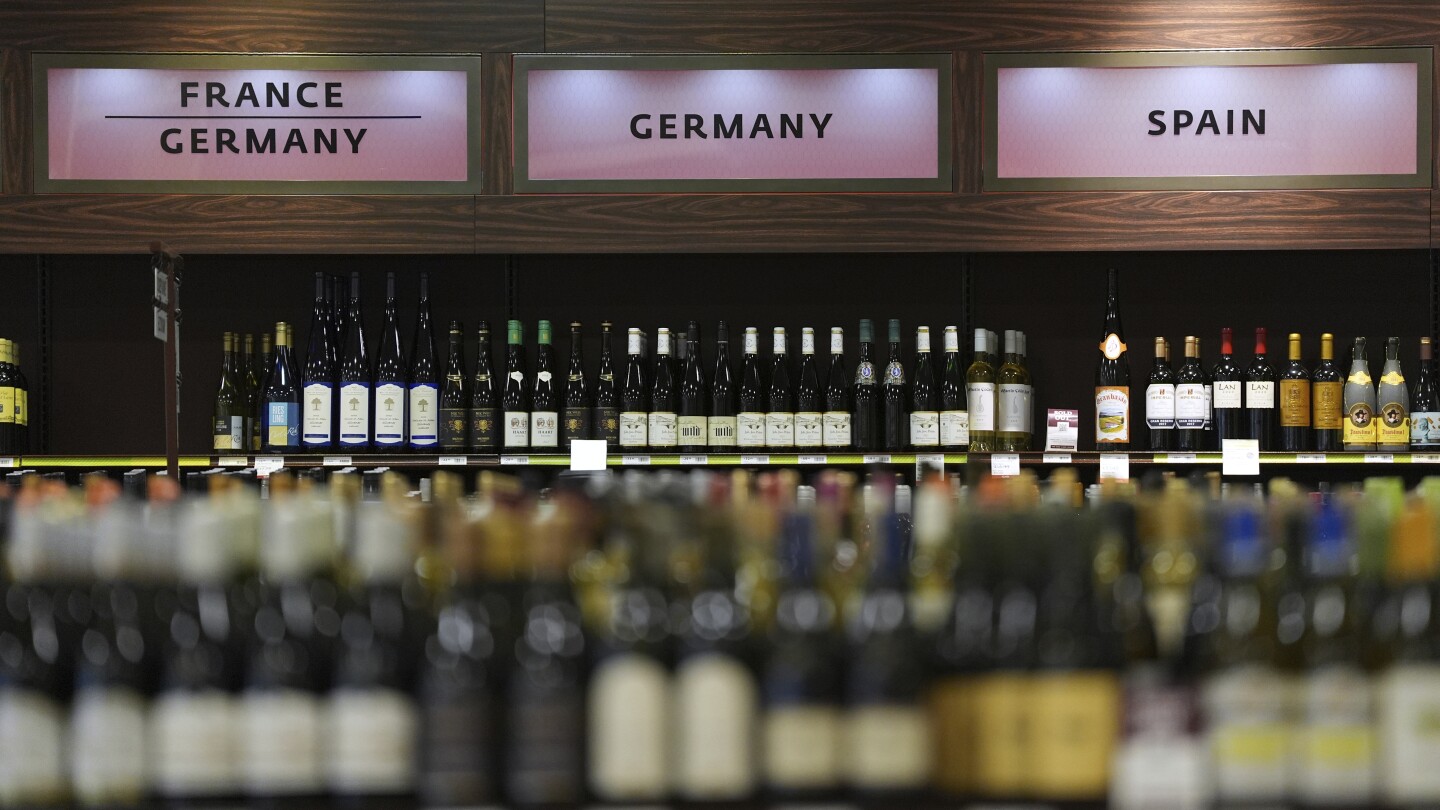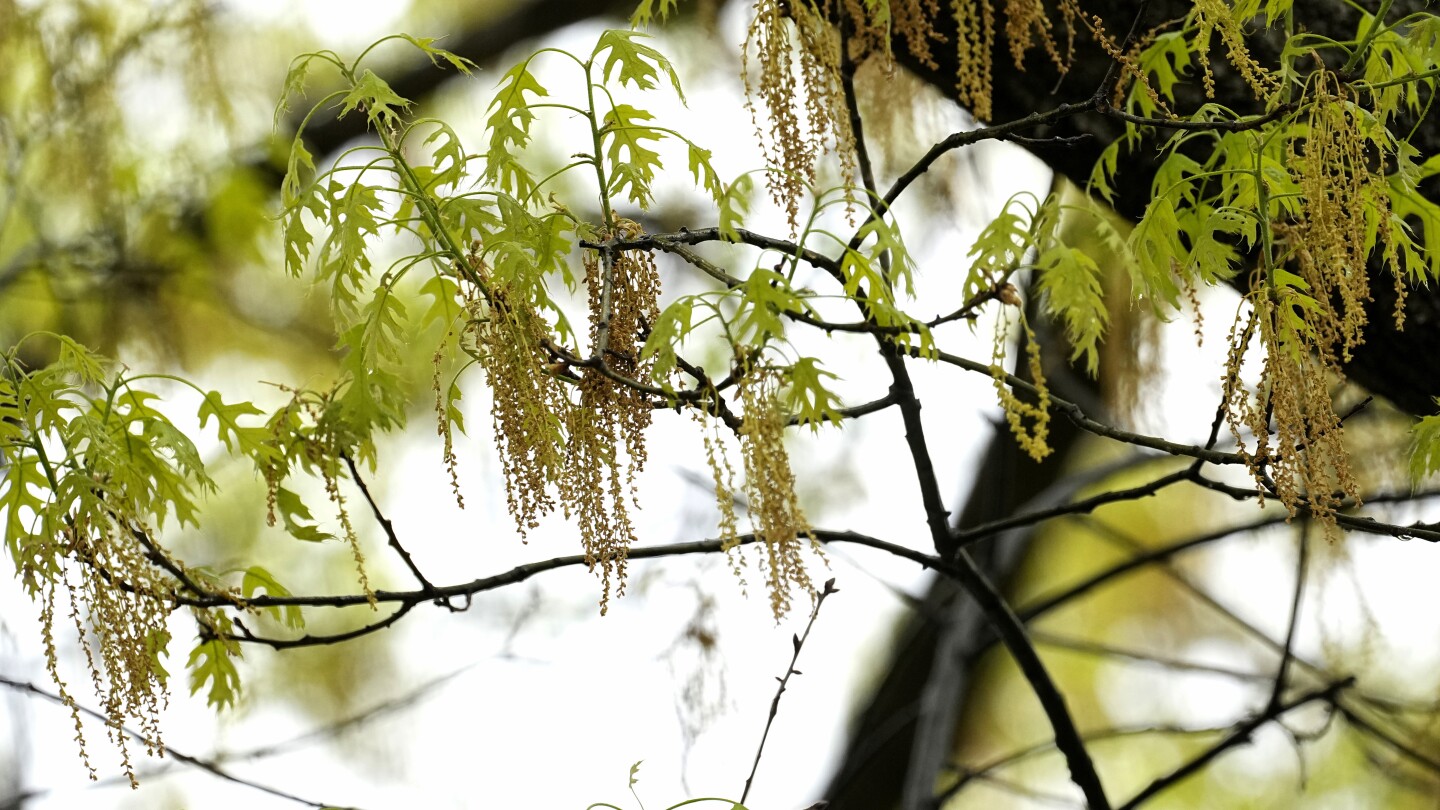Lifestyle
US wine shops and importers say Trump’s threatened 200% tariff on European wines would kill demand

The United States is suddenly looking less bubbly for European wines.
President Donald Trump on Thursday threatened a 200% tariff on European wine, Champagne and spirits if the European Union goes forward with a planned 50% tariff on American whiskey. Wine sellers and importers said a tariff of that size would essentially shut down the European wine business in the U.S.
“I don’t think customers are prepared to pay two to three times more for their favorite wine or Champagne,” Ronnie Sanders, the CEO of Vine Street Imports in Mt. Laurel Township, New Jersey, said.
Jeff Zacharia, president of fine wine retailer Zachys in Port Chester, New York, said 80% of the wine he sells is from Europe. Importers depend on European wines for a big part of their distribution system, he said, and there’s not enough U.S. wine to make up for that.
“This is just going to have a major negative impact on the whole U.S. wine industry in all aspects of it, including U.S. wineries,” he said.
Zacharia said there are so many unknowns right now he’s stopped buying European wine until the picture becomes clearer.
“It’s very hard to make preparations when as a business you don’t have a clear path forward,” he said. “Our preparations would be very different if it’s 200% compared to 100% compared to 10%.”
Wine and spirits from the 27-nation European Union made up 17% of the total consumed in the U.S. in 2023, according to IWSR, a global data and insight provider specializing in alcohol. Of that 17%, Italy accounted for 7% — mostly from wine – and French wine, cognac and vodka accounted for 5%.
Overall, the U.S. imports much more alcohol than it exports. The $26.6 billion worth of foreign-produced alcoholic beverages that entered the country in 2022 accounted for 14% percent of all U.S. agricultural imports, according to the U.S. Department of Agriculture. The U.S. exported $3.9 billion worth of beer, wine and distilled spirits that year.
Marten Lodewijks, president of IWSR U.S., said a 200% tariff would not be unprecedented but import duties of that size tend to be more targeted.
In 2020, China imposed tariffs as high as 218% on Australian wine, which caused exports to plunge by 90%, Lodewijks said. China lifted the tariffs last year, but by then Australia’s wine industry had taken a big hit. Australia’s wine trade to China was worth 1.1 billion Australian dollars ($710 million) annually before the tariffs were put in place.
Europe’s tax on American whiskey, which was unveiled in response to the Trump administration’s steel and aluminum tariffs, is expected to go into effect on April 1. Trump responded Thursday in a social media post.
“If this Tariff is not removed immediately, the U.S. will shortly place a 200% Tariff on all WINES, CHAMPAGNES, & ALCOHOLIC PRODUCTS COMING OUT OF FRANCE AND OTHER E.U. REPRESENTED COUNTRIES,” Trump wrote. “This will be great for the Wine and Champagne businesses in the U.S.”
Trump was incorrect about the Champagne business. Champagne is a legally protected wine that can only come from France’s Champagne region. But U.S. winemakers — including Trump Winery, a Virginia winery owned by the president’s son Eric Trump — do make sparkling wine.
Reaction from across the Atlantic was swift Thursday.
“We must stop a dangerous escalation that is leading to a global trade war where the first victims will be U.S. citizens who will pay more for products, and with them, farmers,’’ Ettore Prandini, president of Italy’s Coldiretti agriculture lobby, said.
Italian wine exports to the U.S. – led by prosecco — have tripled in value over the last 20 years and reached 1.9 billion euros ($2.1 billion) last year. In France, the U.S. market for wines and spirits is worth 4 billion euros ($4.3 billion) annually.
Gabriel Picard, who heads the French Federation of Exporters of Wines and Spirits, said 200% tariffs would be “a hammer blow” for France’s alcohol export industry, impacting hundreds of thousands of people.
“Not a single bottle will continue to be expedited if 200% tariffs are applied to our products. All exports to the United States will come to a total, total, halt,” Picard said in an interview with The Associated Press.
French transporter Grain de Sail, which uses sail power to ship wines and other goods across the Atlantic, said Thursday that some winemakers had already cancelled planned shipments of wine to the U.S. because they were anticipating tariffs even before Trump’s announcement.
“It has more or less frozen exports. There’s no point even hoping to send wine to the United States under these conditions,” said Jacques Barreau, the firm’s co-founder.
Some U.S. wine stores saw an opportunity Thursday. In Washington, the wine bar Cork announced a tariff sale, encouraging regulars to come stock up on their favorite wines while they’re still affordable.
Others wondered aloud whether Trump would really go through with a 200% tariff.
“It changes by the hour now, right?” Mark O’Callaghan, the founder of Exit 9 Wine & Liquor Warehouse in Clifton Park, New York, said. European wines make up around 35% of sales at his store, he said.
Others seemed to want to stay out of the fray. Total Wine, which operates 279 stores in 29 U.S. states, didn’t respond to a request for comment Thursday. Southern Glazer’s Wine & Spirits, one of the country’s largest alcohol distributors, also didn’t respond to a message seeking comment.
___
Anderson reported from New York. Durbin reported from Detroit. AP Writers Colleen Barry in Rome, John Leicester in Paris and Zeke Miller in Washington contributed.
Lifestyle
Allergy season: How to check pollen levels and alleviate symptoms

ATLANTA (AP) — Allergy season can be miserable for tens of millions of Americans when trees, grass, and other pollens cause runny noses, itchy eyes, coughing and sneezing.
Where you live, what you’re allergic to and your lifestyle can make a big difference when it comes to the severity of your allergies. Experts say climate change is leading to longer and more intense allergy seasons, but also point out that treatments for seasonal allergies have become more effective over the last decade.
Here are some tips from experts to keep allergy symptoms at bay — maybe even enough to allow you to enjoy the outdoors.
Where are pollen levels the worst this year?
The Asthma and Allergy Foundation of America issues an annual ranking of the most challenging cities to live in if you have allergies, based on over-the-counter medicine use, pollen counts and the number of available allergy specialists.
This year, the top five cities are: Wichita, Kansas; New Orleans; Oklahoma City; Tulsa, Oklahoma; and Memphis.
Which pollens cause allergies?
There are three main types of pollen. Earlier in the spring, tree pollen is the main culprit. After that grasses pollinate, followed by weeds in the late summer and early fall.
Some of the most common tree pollens that cause allergies include birch, cedar, cottonwood, maple, elm, oak and walnut, according to the Asthma and Allergy Foundation of America. Grasses that cause symptoms include Bermuda, Johnson, rye and Kentucky bluegrass.
This article is part of AP’s Be Well coverage, focusing on wellness, fitness, diet and mental health. Read more Be Well.
How do I track pollen levels?
Pollen trackers can help you decide when to go outside. The American Academy of Allergy Asthma and Immunology tracks levels through a network of counting stations across the U.S. Counts are available at its website and via email.
Limit your exposure to pollens
The best and first step to controlling allergies is avoiding exposure. Keep the windows in your car and your home closed, even when it’s nice outside.
If you go outside, wearing long sleeves can keep pollen off your skin to help ward off allergic reactions, said Dr. James Baker, an allergist at the University of Michigan. It also provides some sun protection, he added.
When you get home, change your clothes and shower daily to ensure all the pollen is off of you — including your hair. If you can’t wash your hair every day, try covering it when you go outside with a hat or scarf. Don’t get in the bed with your outside clothes on, because the pollen will follow.
It’s also useful to rinse your eyes and nose with saline to remove any pollen, experts said. And the same masks that got us through the pandemic can protect you from allergies — though they won’t help with eye symptoms.
How to relieve allergy symptoms
Over-the-counter nasal sprays are among the most effective treatments for seasonal allergies, experts said.
But the vast majority of patients use them incorrectly, irritating parts of the nose, said Dr. Kathleen Mays, an allergist at Augusta University in Georgia. She suggested angling the nozzle outward toward your ear rather than sticking it straight up your nose.
Over-the-counter allergy pills like Claritin, Allegra and Zyrtec are helpful, but may not be as effective as quickly since they’re taken by mouth, experts said.
Experts also said that if your allergy symptoms are impacting your quality of life, like causing you to lose sleep or a lack focus at work or school, it might be time to consider an allergist appointment for immunotherapies.
Some remedies for allergy relief that have been circulating on social media or suggested by celebrities — like incorporating local honey into your diet to expose yourself to pollen — have been debunked.
Dr. Shayam Joshi, an allergist at Oregon Health and Science University, said that’s because the flowers that bees pollinate typically don’t contain the airborne pollen that causes allergy symptoms.
Is allergy season changing?
With climate change, winters are milder and growing seasons are longer, meaning there’s more opportunity for pollen to stay in the air, resulting in longer and more severe allergy seasons.
In many areas across the country, pollen counts have broken decades of records. In late March, the Atlanta Allergy and Asthma Center measured a pollen count of over 14,000 grains per cubic meter, which is considered extremely high.
___
The Associated Press Health and Science Department receives support from the Howard Hughes Medical Institute’s Science and Educational Media Group and the Robert Wood Johnson Foundation. The AP is solely responsible for all content.
Lifestyle
The 250th anniversary of the Battles of Lexington and Concord opens debate over US independence
NEW YORK (AP) — The American Revolution began 250 years ago, in a blast of gunshot and a trail of colonial spin.
Starting with Saturday’s anniversary of the Battles of Lexington and Concord, the country will look back to its war of independence and ask where its legacy stands today.
The semiquincentennial comes as President Donald Trump, the scholarly community and others divide over whether to have a yearlong party leading up to July 4, 2026, as Trump has called for, or to balance any celebrations with questions about women, the enslaved and Indigenous people and what their stories reveal.
The history of Lexington and Concord in Massachusetts is half-known, the myth deeply rooted.
What exactly happened at Lexington and Concord?
Reenactors may with confidence tell us that hundreds of British troops marched from Boston in the early morning of April 19, 1775, and gathered about 14 miles (22.5 kilometers) northwest on Lexington’s town green.
Firsthand witnesses remembered some British officers yelled, “Thrown down your arms, ye villains, ye rebels!” and that amid the chaos a shot was heard, followed by “scattered fire” from the British. The battle turned so fierce that the area reeked of burning powder. By day’s end, the fighting had continued around 7 miles (11 kilometers) west to Concord and some 250 British and 95 colonists were killed or wounded.
But no one has learned who fired first, or why. And the revolution itself was initially less a revolution than a demand for better terms.
Woody Holton, a professor of early American history at the University of South Carolina, says most scholars agree the rebels of April 1775 weren’t looking to leave the empire, but to repair their relationship with King George III and go back to the days preceding the Stamp Act, the Tea Act and other disputes of the previous decade.
“The colonists only wanted to turn back the clock to 1763,” he said.
Stacy Schiff, a Pulitzer Prize winning historian whose books include biographies of Benjamin Franklin and Samuel Adams, said Lexington and Concord “galvanized opinion precisely as the Massachusetts men hoped it would, though still it would be a long road to a vote for independence, which Adams felt should have been declared on 20 April 1775.”
But at the time, Schiff added, “It did not seem possible that a mother country and her colony had actually come to blows.”
A fight for the ages
The rebels had already believed their cause greater than a disagreement between subjects and rulers. Well before the turning points of 1776, before the Declaration of Independence or Thomas Paine’s boast that “We have it in our power to begin the world over again,” they cast themselves in a drama for the ages.
The so-called Suffolk Resolves of 1774, drafted by civic leaders of Suffolk County, Massachusetts, prayed for a life “unfettered by power, unclogged with shackles,” a fight that would determine the “fate of this new world, and of unborn millions.”
The revolution was an ongoing story of surprise and improvisation. Military historian Rick Atkinson, whose “The Fate of the Day” is the second of a planned trilogy on the war, called Lexington and Concord “a clear win for the home team,” if only because the British hadn’t expected such impassioned resistance from the colony’s militia.
The British, ever underestimating those whom King George regarded as a “deluded and unhappy multitude,” would be knocked back again when the rebels promptly framed and transmitted a narrative blaming the royal forces.
“Once shots were fired in Lexington, Samuel Adams and Joseph Warren did all in their power to collect statements from witnesses and to circulate them quickly; it was essential that the colonies, and the world, understand who had fired first,” Schiff said. “Adams was convinced that the Lexington skirmish would be ‘famed in the history of this country.’ He knocked himself out to make clear who the aggressors had been.”
A country still in progress
Neither side imagined a war lasting eight years, or had confidence in what kind of country would be born out of it. The founders united in their quest for self-government but differed how to actually govern, and whether self-government could even last.
Americans have never stopped debating the balance of powers, the rules of enfranchisement or how widely to apply the exhortation, “All men are created equal.”
“I think it’s important to remember that the language of the founders was aspirational. The idea that it was self-evident all men were created equal was preposterous at a time when hundreds of thousands were enslaved,” said Atkinson, who cites the 20th-century poet Archibald MacLeish’s contention that “democracy is never a thing done.”
“I don’t think the founders had any sense of a country that some day would have 330 million people,” Atkinson said. “Our country is an unfinished project and likely always will be.”
Lifestyle
Sweets from the sky! A helicopter marshmallow drop thrills kids in suburban Detroit

ROYAL OAK, Mich. (AP) — It’s spring in Detroit — warm weather, a few clouds, and a 100% chance of marshmallow downpours.
The source? A helicopter zooming above the green lawn of Worden Park on Friday, unloading sack-fulls of fluffy treats for hundreds of kids waiting eagerly below, some clutching colorful baskets or wearing rabbit ears.
The children cheered and pointed as the helicopter clattered by on its way to the drop zone. Volunteers in yellow vests made sure kids didn’t rush in and start grabbing marshmallows until after the deluge was complete.
For anyone worried about hygiene, don’t fret. The annual Great Marshmallow Drop isn’t about eating the marshmallows — kids could exchange them for a prize bag that included a water park pass and a kite.
The marshmallow drop has been held for over three decades in the Detroit suburb of Royal Oak, Michigan, hosted by Oakland County Parks.
One toddler, Georgia Mason, had no difficulty procuring a marshmallow at her first drop, her dad Matt said.
“Probably the most exciting part was seeing the helicopters. But once we saw the marshmallows drop, we got really excited,” Matt Mason said.
“And, yeah, we joined the melee,” he said, “We managed to get one pretty easy.”
Organizers said 15,000 marshmallows were dropped in all.
The helicopter made four passes, dropping marshmallows for kids in three age categories: 4-year-olds and younger, 5-7-year-olds, and those ages 8 to 12. A drop for kids of all ages with disabilities came later in the day.
“We do it because it’s great for community engagement,” Oakland County recreation program supervisor Melissa Nawrocki said.
“The kids love it,” she continued. “The looks on their faces as they’re picking up their marshmallow and turning in the marshmallow for prizes is great.”
-

 Education1 day ago
Education1 day agoHarvard’s battle with the Trump administration is creating a thorny financial situation
-

 Sports2 days ago
Sports2 days agoAaron Rodgers ‘not holding anybody hostage’ as he decides his future, retirement a possibility
-

 Europe1 day ago
Europe1 day agoTrump’s ‘lone ranger’: How Steve Witkoff became the defacto point man on America’s foreign policy challenges
-

 Middle East7 hours ago
Middle East7 hours agoIran says progress in nuclear talks with US, confirms third round next week | News
-

 Middle East15 hours ago
Middle East15 hours agoTunisian court hands opposition figures lengthy jail terms | Human Rights News
-

 Conflict Zones1 day ago
Conflict Zones1 day agoTrump says US may ‘pass’ on helping end war if Russia, Ukraine resist deal | Russia-Ukraine war News
-

 Europe1 day ago
Europe1 day agoThe Trump administration says Europe is taking advantage of the US. That’s not exactly true
-

 Lifestyle1 day ago
Lifestyle1 day agoSweets from the sky! A helicopter marshmallow drop thrills kids in suburban Detroit



